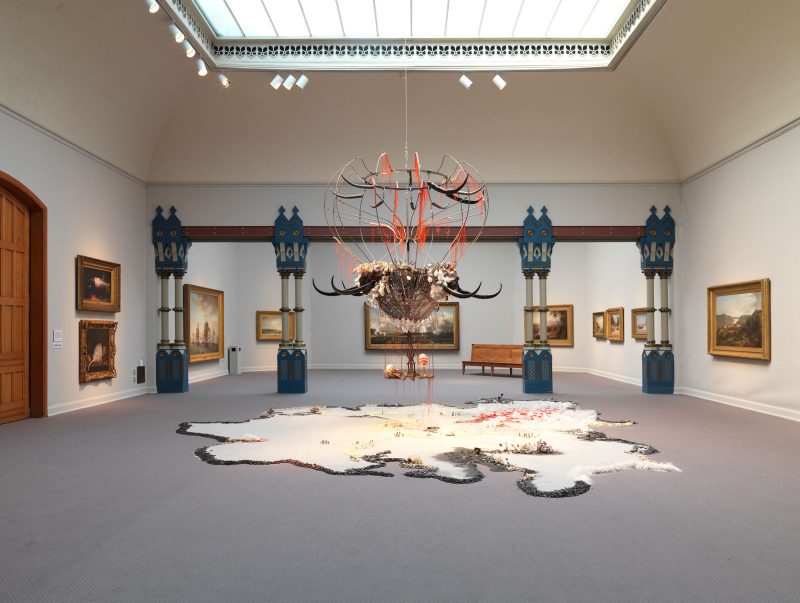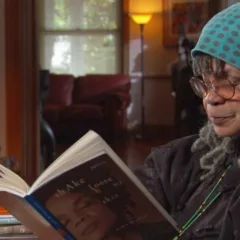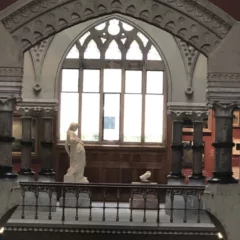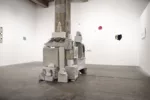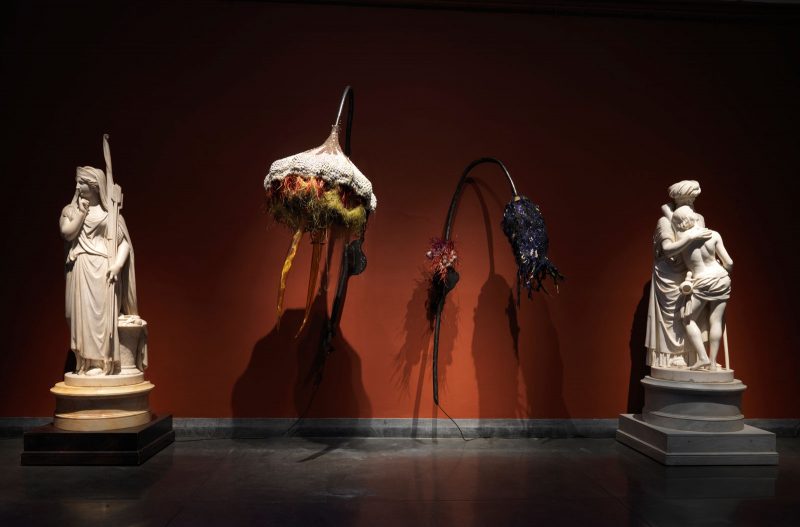
Rina Banerjee’s artworks occupy the galleries of the Pennsylvania Academy of Fine Art (PAFA) like creatures from another world. The Frank Furness building’s 18th, 19th and early 20th-century paintings are a staid background to the scale and exuberance of her work — expansive, intensely colored, made from accretions of highly diverse, natural and man-made materials. Many of her forms are organic, but others refer to furnishings and architecture. These 24 sculptures and installations, 28 works on paper and two videos could only be products of the Twenty-first Century: fashioned from large quantities of materials of international origin and sourced via the internet (which is much more efficient than the Silk Road in effecting the exchange of goods).
Eclectic materials suggest many stories
Banerjee creates hybrid forms and creatures in the process of transition — between human, animal, vegetable and divine incarnations — which are the subject of so many myths, fairy tales and religious narratives across time and cultures. “The world as burnt fruit – When empires feuded for populations and plantations, buried in colonial and ancient currency a Gharial appeared from an inky melon – hot with blossom sprang forth to swallow the world not yet whole as burnt fruit” (2009) is a large installation in which the head of a gharial (an Asian crocodile now found only in India and Nepal) emerges from a pod-shaped object. The creature’s neck is formed out of a rope of gourds surrounded by what look like fuscia-colored flowers. These flowers are constructed from feathered-fans with “made in China” labels pasted to the handles and visible up close. The pod itself is fashioned from Japanese mosquito net stretched over a metal armature and the opening from which the head appears is encrusted with cowrie shells.
This description of “The world as burnt fruit …,” reveals two consistent qualities of Banerjee’s art. The first is a richly, sensual appeal: the materials seduce the eye with abundant color, form and sparkle; textured surfaces beg to be touched and she occasionally includes sounds and fragrances to tempt the other senses. The second is the quality of story-telling, in elliptical and poetic form, that runs through the work. Her titles are as evocative as the artworks and equally refuse to be tied to a single narrative. Banerjee’s work is generous — it offers a wealth of visual stimulation and allusive material but allows the viewer to construct her own story line.
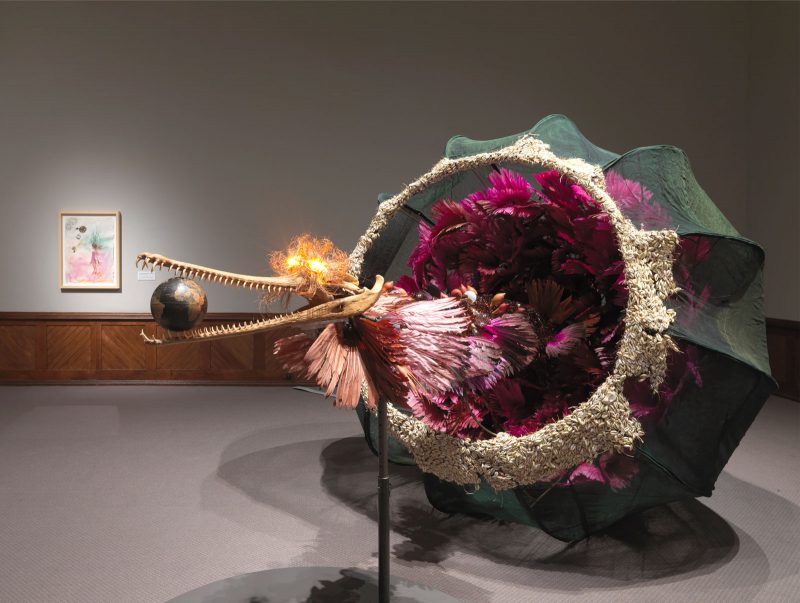
Tracing the routes of colonial exchange
A major theme of Banerjee’s is the fungibility of goods and the inequities that follow when their trade reflects an uneven balance of power and knowledge. She employs cowrie shells that have functioned as currency since prehistory, glass beads that Europeans exchanged for enslaved Africans, spices and silks that moved from East to West in exchange for the cotton and wool that journeyed East, tourist souvenirs and cheaply-made household goods which the Third World produces to exchange for Western currency.
Another, interconnected theme is colonialism and its aftereffects. European countries that were happy to exploit the labor and natural resources of Africa, Asia and Latin America have been unwilling to acknowledge the effects of that exploitation or accept their formerly-colonial subjects as equals. Rather than emphasizing the commonality of us all, generations of Orientalist artist and writers have depicted the populations of much of the world as exotic objects for Western delectation, with little more agency than the fruit in a still life. Banerjee’s work gives voice to a broad range of non-Western cultures via the goods they have produced and the natural materials they have gathered.
Almost all of the works on paper include human — or at least partially human — forms; some have four arms, others have claws, a fish tail or wings. Banerjee works in high-keyed colors with delicate lines and washes. She often uses mixed media, not only drawing with various combinations of acrylic paint, watercolors and ink, but adding collage elements of paper, glitter, mica, and pearls. The figures are shown at multiple scales within a work and with a perspectival system that can only be described as dream-like. Aspects of her drawing style appear throughout her three dimensional work, where she handles certain materials, particularly thread, netting, feathers, plastic tubing, stalks of vines and bundles of greenery, with the lightness of ink lines.
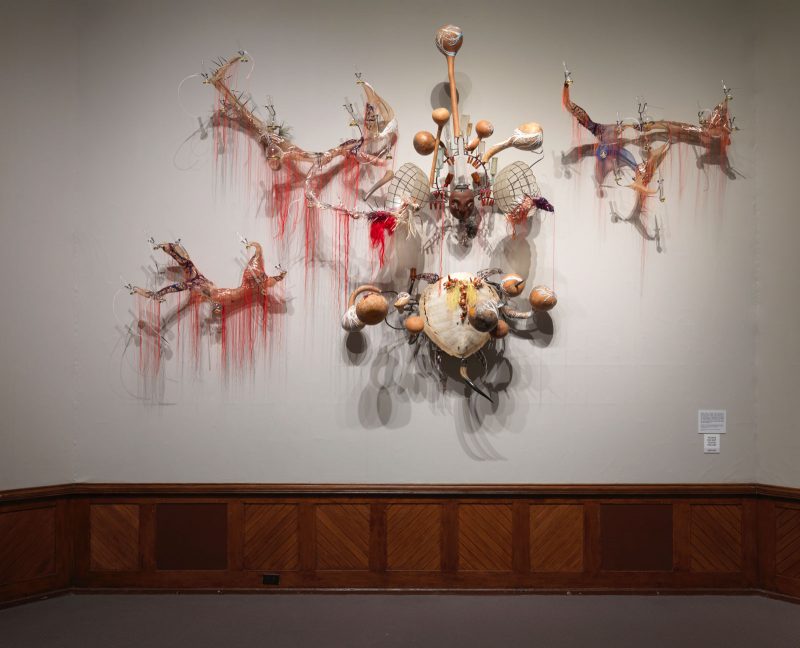
A citizen of the art world
While Banerjee works with a variety of Asian and African textiles, furniture and artifacts, her art speaks the Esperanto of the art world. The Brooklyn-based artist had lived in three countries by the time she was eleven, and has an MFA from the Yale School of Art. She has joined that group of artists whose work is in international demand on a frequent basis, and I suspect she always keeps a bag packed. Last year her work was shown in Tokyo (twice), San Francisco, Sète France, Singapore, Venice, Daejeon S. Korea, New York and New Orleans. And other than the works on paper, the artist needs to install the works herself.
The decision to present the exhibition within galleries of American paintings surprised me, but it looks splendid — and surprisingly, the paintings are still readily viewable. PAFA’s high-ceilinged galleries and transitional spaces make much more congenial settings for Banerjee’s work than the conventional, white-walled spaces of contemporary art museums which lack architectural detail. Her art is powerful, rich with ideas and takes its place comfortably within the polychrome eclecticism of Frank Furnesses masterful building. Jodi Throckmorton, PAFA’s curator of contemporary art, is to be roundly congratulated, as are the many art handlers who must have been involved in an extraordinarily technically-demanding installation! The exhibition is accompanied by an appropriately-handsome catalog.
“Rina Banerjee: Make Me a Summary of the World” will be on view through March 31, 2019 before traveling to San Jose, Los Angeles, Nashville and Durham, NC. A range of associated programming is listed on PAFA’s website
